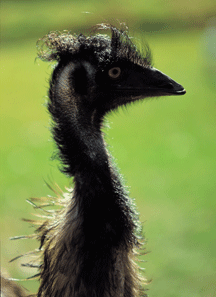Ostrich & Emu
Revised November, 2021.
Overview
The ostrich, a flightless bird that belongs to the ratite (RAT tight) family and originates from Africa, is the world’s largest living bird. When fully grown, the ostrich (Struthio camelus) weighs approximately 450 pounds and stands eight feet tall. Emus are also ratites but native to Australia. They weight 125 to 140 pounds and stand about six feet tall.
The ostrich and emu industries are attempting to recover from a significant economic shakedown. Having experienced tremendous growth during the 1990s, the industry outproduced its ability to develop consistent demand that could support the inflated values placed on breeding pairs and chicks.
History
Although ostrich farming faded in the United States during the early 1930s, it regained popularity in the early 1990s in the eastern part of the United States. It promised a way to diversify existing farming operations, and it provided an opportunity for new producers to enter production agriculture. The potential for rapid returns and huge profits from selling breeding stock, meat and other byproducts attracted investment dollars from every segment of the economy.
As more and more people got into production, breeding supplies became plentiful and prices dropped. In order to embark on commercial production, bird numbers have to be increased to a level where there are sufficient birds so that some can be taken out of breeding and slaughtered for meat. Once this level has been reached, it has to be maintained so that consistent supplies of meat can be generated. However, markets for ratite meat and other products did not develop as anticipated.
Although the meat is a high-quality product, producers were not able to develop a large enough consumer base willing to pay the additional costs to purchase the product. (Ratite meat cuts often ran several dollars a pound more than comparable beef cuts.) Despite uncertainty in the market, the industry continued to overproduce at a rate that quickly flooded the market. Overproduction subsequently led to dramatic price declines that eliminated a significant portion of the production operations. Prices for birds plummeted from highs of 25 to 50 thousand dollars per breeding pair to as low as a thousand dollars per pair. Fertile eggs and chicks that once brought as much as a thousand dollars or more each were now sold for less than a hundred dollars.
The surviving ratite producers that have weathered this economic storm still face the same fundamental problem the industry started with: how to grow production numbers and market demand at a rate that complements each other. Although the illusion of getting quick profits is long past, there remains strong sentiment for a bird that provides healthy meat products, versatile oils and outstanding leather products.
Production
According to the American Ostrich Association, there is no single, reliable, comprehensive source of information on production, prices and markets for ostrich products.
The 2012 Census of Agriculture notes that 258 farms raised 6,540 ostriches and marketed about 3,141. This is a dramatic decrease from 2007, when 714 farmers raised 11,188 ostriches and marketed about 5,697. This continues declines from 2002. Texas, followed by California and Kansas, are the top three states in ostrich production. Texas is also number one in the production of emus, followed by California and Florida.
Ostrich production can be adopted by small-scale and part-time farmers with adequate investment capital because land and husbandry requirements are minimal.
Value-added Products
In the past, the major market for ostriches was breeding stock. In order for the ostrich industry to become a more viable agricultural enterprise, the markets for meat, oil, skin (leather), feathers and eggs need to be further developed.
Ratite meat has a gourmet market. With a texture and color similar to beef, it is low in fat, calories and sodium. It has fewer calories, less fat and less cholesterol than beef, chicken or turkey. It also is a good source of iron and protein. Ground ostrich sells for $10.35 per pound, and ostrich filet steaks sell for $24.90 per pound.
Ratite oils are used extensively in the cosmetics and pharmaceutical industry. They are reputed to have exceptional moisturizing, penetrating and therapeutic qualities for humans and animals. Some clinical testing indicates that emu oil may have anti-inflammatory properties and possibly skin de-sensitizing properties. Oil and cosmetics using ratite oils are sold in health food stores and on the Internet. Fully refined emu oil currently sells for roughly $160 per gallon.
Ostrich skin has a distinctive quill pattern that is highly valued for boots, handbags and billfolds. The market for ostrich feathers is limited, but they can be used to clean fine machinery and equipment. Egg shells are carved into ornaments, used as containers or made into decorative jewelry. Ostrich farmers may also sell eggs for hatching. Priced at $40-$75, each fresh egg weighs 4 pounds and is the equivalent of 24 chicken eggs. Egg shells cost $20 each.
Government Regulations
USDA FSIS inspection is required for all ratites. To move among states or to be exported, birds and their byproducts must be slaughtered in a federally inspected meat plant.
Outlook
Some of the obstacles hampering progress toward a successful ostrich industry are the need to develop sustainable markets for meat and leather products; lack of research into ostrich production; and lack of infrastructure to ensure producers can slaughter and process birds when they are ready for market.
Sources
- American Ostrich Association - Membership organization that provides information about the industry and promotes products.
- Ratites Fact Sheet - Food Safety and Inspection Service, USDA, 2013 - Focus on ostrich, emu and rhea.
Other Links
- American Emu Association - Membership-based organization for the development and promotion of the industry. Provides several online libraries of information of interest to the emu farmer.



